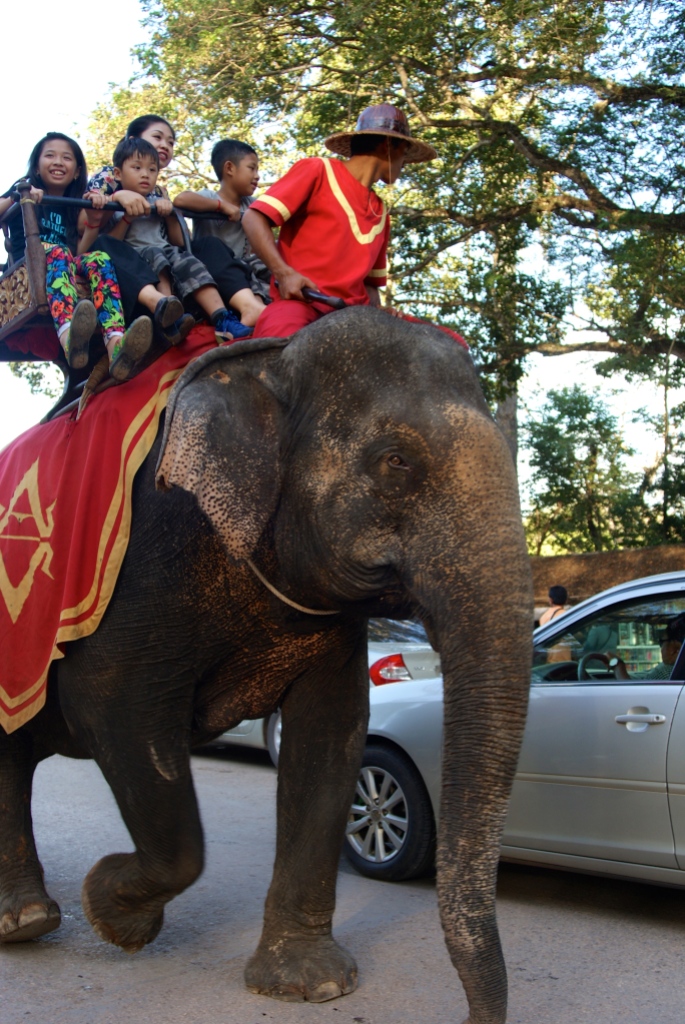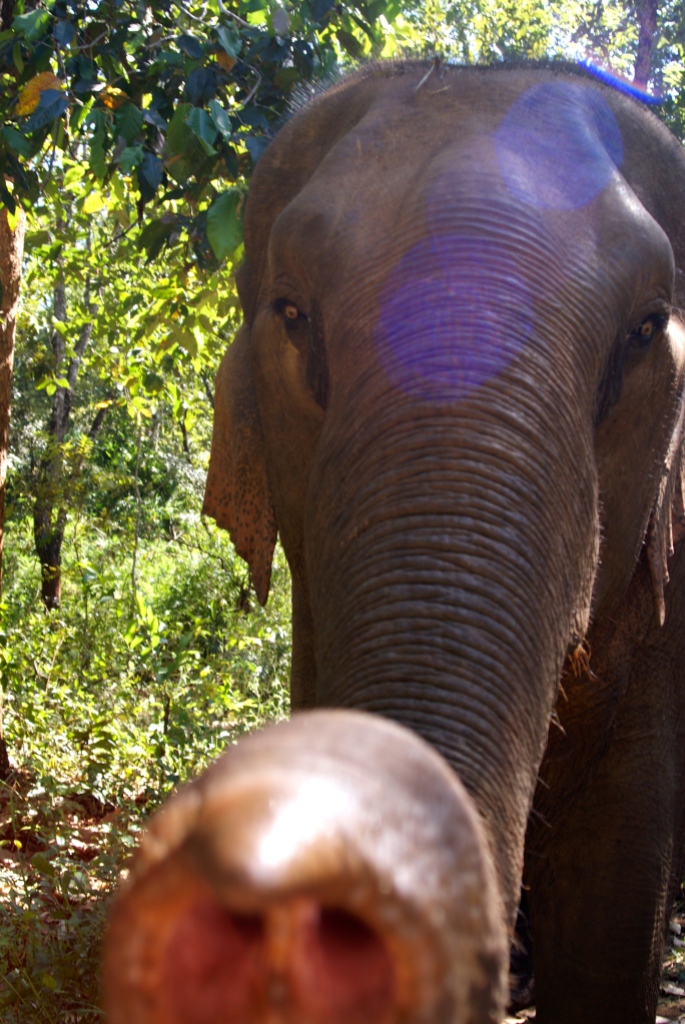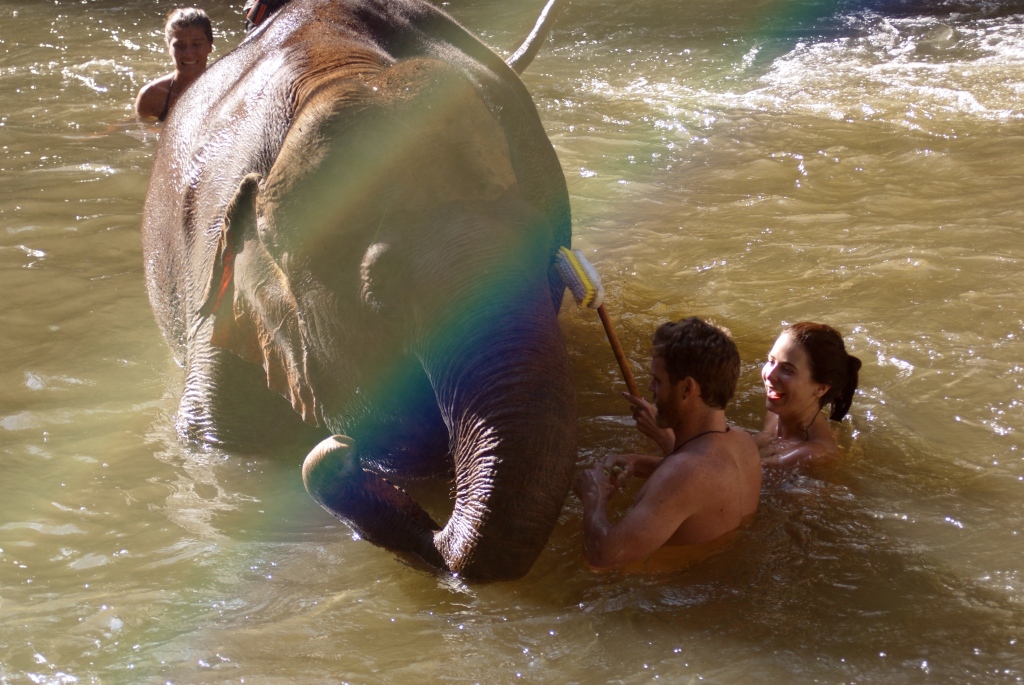We leave Sihanouk and head for Phnom Penh for a quick one night stop over before heading for an elephant conservation project in the highlands of the Mondulkuri province.
It takes about 7 hours on a packed mini bus, with Catherine and I the only tourists. Its refreshing to be amongst the local populace after the tourist hub of Sihanouk and its an eye opening experience in the foods they eat on a day to day basis. We stop at a roadside… service station for lack of a better descriptive word. Though its more like a single fuel pump with an attached snack stand. The guy next to us on the bus is eating strange fruit that I’ve never seen before – something like a lychee but with a green skin with feelers. We buy some dried kubara chips to snack and impatiently wait for the bus to arrive at Sen Monorom – the closest town to our destination. We start to emerge into the highlands, and its a interesting landscape; high hills that have been cleared on top for farms and dwellings, but then roll down into jungle filled valleys and ravines where water has carved them out over the eons. Its hot and humid still despite being a milder 28c rather than the 34c of the low lands.
Sen Monorom is not worth a picture and certainly not much to write home about. Its about two main streets and is a kind of a largish country town. We arrange our lift to the project huts on the far side of town and settle in for a surprisingly delicious chicken schnitzel with mushroom sauce at an odd German themed restaurant while we wait. Its a refreshing change from the constant buffet of rice and noodles we have been gorging on.
The Mondulkuri Project is a conservation effort to save elephants from a life of hardship. Run by the jovial and thoughtful Mr Tree, it has 5 elephants at the time of our visit, who live naturally in the jungle and basically do what they please. Each has been rescued from either a life of brutal farm labour or even worse, being ridden by tourists with a wooden chassis strapped to their back.
Let me explain some math for a moment. Elephant math if you will. The average Cambodian elephant is worth around $40,000 USD, and can make around $10,000-$20,000 a year if in the tourist trade. These elephants work 12 hours a day, every day of the year with limited food and water carrying obnoxious tourists around for their cheap thrills and the profit of the owner. $10-20k is a lot of money for a Cambodian – after all this is one of the cheapest places on the planet. These elephants can live up to 80 odd years in the natural habitats in the wild. In the tourist trade – maybe 20 – 30 years. They are pretty much worked to an early grave.
Might make you think twice about the next time you want to ride one?

The other thing they are used for by many of the local villages are to carry timber and tree sap (a valuable resource) through the forest. The problem here is in the way this tree sap is harvested and it can burn like acid. Several of the saved elephants here have scars from this dripping down their backs in their previous lives. Its a hard elephant life it seems.
So Mr Tree, with some investment by an Australian benefactor has set about buying up those he can and bringing them here to his jungle sanctuary to live their life in peace. But wait – we are here as tourists so how peaceful can it be for them? Well read on my friend and let me tell you how we are made to feed the bananas and scrub the mud from their backs.
We stay in some authentic wooden huts at the projects base in Sen Monorom which is run by Mr Tree’s amiable wife. The food there is delicious once again and its a nice relief to be in huts with no power and a wonderful stone shower filled with plants. A very cleansing way to cleanse I must say.
We have signed up on a 2 day trek which involves a ride to the elephant hut, where we will sleep the night in hammocks over looking the jungle covered valley below where the elephants call home. Mr Tree briefs us about the project and about the elephants before loading us up with bananas to go and bring them some tasty fruit snacks.
The elephants are truly amazing creatures. Intimidating at first, they crash through the jungle and march forcefully up to our group. We hesitate and shy back a touch; at well over 2m tall and several tons you do not want to get in their way, but they pull up just short of us and then one throws its head back and opens its mouth, while the other snakes its trunk toward us searching…

They know we have bananas. They are wise creatures with good memory. Tree tells us a story about one of them who use to pass a shop every day and the owner would give it a bannana. One day, the owner has no banana, so the elephants fills up his trunk in a nearby water trough and sprays the owner. Funny and it illustrates the point.
The personalities are vastly different – Lucky wants you to walk up and stick them in her mouth. Lazy beast she is, and the other, uncomfortable with that level of intimacy, grabs them from your hand or behind your back with her trunk.
We stand around in awe of these creatures, slowly letting them rob us blind of our banana cargo. Playing little games with them of hide the banana. They aren’t fooled easy, and if you turn your back you quickly find a trunk probing your hands for a stray easy grab banana.
There’s almost a sadness to their deep dark eyes, age beyond what we are used to in most animals, and these two have both experienced suffering for a long time. Though they are happy here. Masters of their own free will, they come and go as they please and have healthy diets and luscious habitat to meander around in.
We leave these two promptly and visit the other three – these ones are a touch smaller and hang on the other side of the river amongst a thicket of bamboo. They are scared of Lucky apparently. She is the alpha and rather than fall into betaness, the leader of this pack made the bold decision to break away. Though they all have friends and are happy so what does it matter?
We break for a lunch of rice and stir-fry before the afternoon’s agenda; swim with and wash them in a waterfall.
This is A M A Z I N G in every sense.
To be so close and intimate with these beasts is a rare experience. Ive never seen Catherine so happy; grinning from ear to ear and covered in mud from Lucky, she scrubs her back vigorously with a brush as I swim near by savouring the moment as the sun trickles through the jungle canopy above.
We spend the night in old army hammocks clustered in a wooden shelter atop the hill. We have bamboo soup for dinner – a local delicacy of the Bunong tribes people who have dwelt in this area for a very long time. Its delicious and spicy, with a consistency of porridge and is cooked atop a fire in a tube of green bamboo.
We sleep long and well and the next morning we rise early, break our fast and then return down to the elephants.
We walk for most of the rest of the day. Through the hot dry open grass lands and through thick covered jungle. Dense bamboo patches and steep forest floor littered with leaves. Its hot, humid work and we are eager for lunch and another swim in another waterfall before another long afternoon of hiking around the hills.
We finish up in a local village with a dozen or so pigs a handful of patchwork timber huts and a half dozen houses. Mr Tree arrives later to pick us up and drop off his quarterly aid donation – a few 50kg bags of rice and other assorted goods. Everyone mills around and are all smiles as stray dogs and chickens meander around our feet.
We spend the night back at the wooden huts in Sen Monorom before taking the early bus back to Phenom Penh the next day.



































